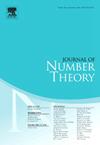射影维增长界的最终紧性:二次度
IF 0.6
3区 数学
Q3 MATHEMATICS
引用次数: 0
摘要
在射影维增长结果中,我们用C(n)d2Hn−1(log (H)M(n)限定了Pn度为d>;3的不可约超表面上高度不超过H的有理点的个数,其中d的二次依赖关系最近由Binyamini、Cluckers和Kato在2024年得到。对于这些边界,Castryck, Cluckers, Dittmann和Nguyen在2020[3]中已经表明,在d上不能做得比线性相关更好。在本文中,我们表明,对于上述投影维增长边界,当n增长时,d上的二次相关最终是紧密的。更准确地说,上界一般不能优于c(n)d2−2/nHn−1。注意,对于仿射维数的增长(对于d次的仿射超曲面,满足一些额外的条件),对d的依赖也是[1]的二次,它已经被[3]知道是最优的。因此,我们的投影情况补充了超曲面的尺寸增长边界的紧密性。本文章由计算机程序翻译,如有差异,请以英文原文为准。
Eventual tightness of projective dimension growth bounds: Quadratic in the degree
In projective dimension growth results, one bounds the number of rational points of height at most H on an irreducible hypersurface in of degree by , where the quadratic dependence in d has been recently obtained by Binyamini, Cluckers and Kato in 2024 [1]. For these bounds, it was already shown by Castryck, Cluckers, Dittmann and Nguyen in 2020 [3] that one cannot do better than a linear dependence in d. In this paper we show that, for the mentioned projective dimension growth bounds, the quadratic dependence in d is eventually tight when n grows. More precisely the upper bounds cannot be better than in general. Note that for affine dimension growth (for affine hypersurfaces of degree d, satisfying some extra conditions), the dependence on d is also quadratic by [1], which is already known to be optimal by [3]. Our projective case thus complements the picture of tightness for dimension growth bounds for hypersurfaces.
求助全文
通过发布文献求助,成功后即可免费获取论文全文。
去求助
来源期刊

Journal of Number Theory
数学-数学
CiteScore
1.30
自引率
14.30%
发文量
122
审稿时长
16 weeks
期刊介绍:
The Journal of Number Theory (JNT) features selected research articles that represent the broad spectrum of interest in contemporary number theory and allied areas. A valuable resource for mathematicians, the journal provides an international forum for the publication of original research in this field.
The Journal of Number Theory is encouraging submissions of quality, long articles where most or all of the technical details are included. The journal now considers and welcomes also papers in Computational Number Theory.
Starting in May 2019, JNT will have a new format with 3 sections:
JNT Prime targets (possibly very long with complete proofs) high impact papers. Articles published in this section will be granted 1 year promotional open access.
JNT General Section is for shorter papers. We particularly encourage submission from junior researchers. Every attempt will be made to expedite the review process for such submissions.
Computational JNT . This section aims to provide a forum to disseminate contributions which make significant use of computer calculations to derive novel number theoretic results. There will be an online repository where supplementary codes and data can be stored.
 求助内容:
求助内容: 应助结果提醒方式:
应助结果提醒方式:


